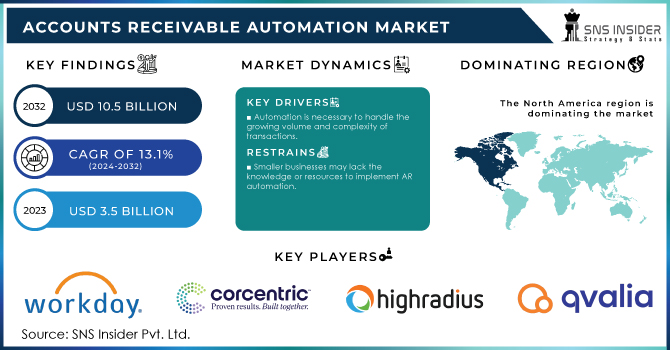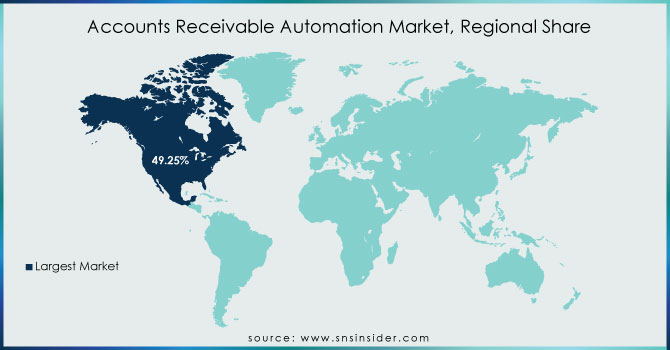Accounts Receivable Automation Market Report Scope & Overview:
The Accounts Receivable Automation Market was valued at USD 3.5 billion in 2023 and is expected to reach USD 10.5 billion by 2032 and grow at a CAGR of 13.1% from 2024- 2032.
The accounts receivable (AR) automation market has seen significant growth as businesses increasingly adopt digital solutions to streamline their financial processes. AR automation involves using technology to automate the repetitive tasks associated with managing incoming payments, invoicing, credit management, and collections, which traditionally have been manual and time-consuming. The market growth is primarily driven by the need for companies to improve cash flow, reduce days sales outstanding (DSO), and enhance overall efficiency in their financial operations.

Get more information on Accounts Receivable Automation Market - Request Free Sample Report
Key factors contributing to this growth include the increasing integration of artificial intelligence (AI) and machine learning (ML) technologies into AR platforms, which enhance predictive analytics capabilities, automate routine decision-making, and provide real-time insights into customer payment behaviors. Cloud-based solutions are also driving market growth, offering scalability, ease of access, and lower implementation costs compared to on-premise systems. The rise of digital payment methods and the increasing volume of transactions further necessitate automation to keep pace with the speed and complexity of modern financial operations.
The need to maintain a healthy cash flow, especially in uncertain economic conditions, has made AR automation a critical component of financial strategy for many organizations. Additionally, the growing emphasis on compliance and data security is pushing companies to adopt advanced AR automation solutions that offer robust reporting and secure processing capabilities.
However, some challenges persist, such as the initial cost of implementation and the need for integration with existing enterprise resource planning (ERP) systems. Despite these hurdles, the benefits of AR automation, such as reduced processing times, improved accuracy, and enhanced visibility into cash flows, are driving widespread adoption. As a result, the AR automation market is poised for continued growth, with technological advancements and increasing awareness of its strategic advantages likely to sustain its upward trajectory.
Market Dynamics
Drivers
-
Automation helps reduce days sales outstanding (DSO) and enhances cash flow.
-
Integration of AI and Machine Learning, Enhances predictive analytics, decision-making, and customer payment behavior insights.
-
Automation is necessary to handle the growing volume and complexity of transactions.
The surge in transactions adds pressure on traditional, manual AR processes, which are prone to errors, delays, and inefficiencies. Automation addresses these challenges by streamlining invoice generation, payment matching, and collections, significantly reducing manual workload and enhancing processing speed.
AR automation tools use technologies like artificial intelligence (AI) and machine learning (ML) to automate data entry, reconcile payments, and flag discrepancies, which minimizes the risk of human error. Studies suggest that companies leveraging AR automation can reduce processing time by up to 80% and cut costs associated with manual processes by 30-40%. Furthermore, these tools provide real-time insights into cash flow and customer payment behaviors, enabling businesses to make informed decisions faster.
The increasing complexity of transactions, driven by global trade, multiple payment methods, and evolving customer expectations, requires sophisticated AR systems that can handle diverse data formats and integrate seamlessly with other business software. Automated AR solutions can process large volumes of transactions efficiently, ensuring quicker payment cycles, reducing days sales outstanding (DSO) by up to 20%, and ultimately improving overall financial health. As the transaction landscape continues to grow in volume and complexity, AR automation becomes not just a convenience but a necessity for modern businesses.
Integration of AI and Machine Learning (ML) in accounts receivable (AR) automation significantly enhances predictive analytics, decision-making, and insights into customer payment behavior. AI-driven AR systems can analyze historical payment data to forecast future cash flows and identify at-risk accounts, improving collections by up to 30%. These technologies enable real-time risk assessments, automate credit decisions, and suggest optimal collection strategies, reducing days sales outstanding (DSO) by 10-20%.
Restraints
-
Reluctance among staff to adopt new technologies and alter traditional workflows.
-
Smaller businesses may lack the knowledge or resources to implement AR automation.
-
Growing worries about data security, privacy, and compliance are a major issue that is affecting the market's expansion.
The risk of system failures in accounts receivable (AR) automation can disrupt financial operations, leading to delayed payments, inaccurate invoicing, and cash flow issues. Studies indicate that nearly 60% of businesses experience at least one significant IT outage annually, with financial operations being highly vulnerable. Such disruptions can cause AR processes to halt, impacting collections and customer relationships. Automation systems rely on complex integrations, and any glitch or downtime can compromise data accuracy and processing speed. This risk underscores the importance of robust backup systems, regular updates, and technical support to ensure continuity and reliability in AR operations.
Segment Analysis
By Deployment
The cloud segment dominated the market with the market share of more than 54.25% in 2023, as cloud-based accounts receivable automation solutions offer a cost-effective and efficient approach to handling large volumes of data. Cloud-based automation solutions offer benefits such as flexibility, scalability, and straightforward implementation, leading to increased adoption of these solutions by organizations around the globe.
Secondly, the on-premises segment is anticipated to grow rapidly during the forecast period due to its high usage among several enterprises, offering full control over infrastructure and assets, on-premises accounts receivable automation solutions are expected to see increased adoption globally in the coming years due to rising concerns over cyber-attacks, data privacy, and security.
By Vertical
The banking, financial services, and insurance (BFSI) sector is projected to hold the largest market share, as it is an early adopter of new technologies. Accounts receivable automation solutions enhance cash collection efficiency for financial institutions by automating the invoicing process. These solutions boost staff productivity by reducing the time spent on data entry, proofreading, and invoice verification, leading to more accurate reporting.
The market growth is primarily driven by the increasing implementation and swift adoption of advanced technologies by healthcare organizations, aimed at providing enhanced and seamless patient services. Healthcare providers need efficient payment acceptance technologies to streamline their operations and elevate the customer experience.
By Component
In 2023, the Solution sector held the largest market revenue share. The segment's growth can be largely attributed to the rising demand for accounts receivable automation solutions within the BFSI sector globally. This sector is increasingly adopting these solutions to enhance payment acceptance services and minimize invoicing errors through its invoice verification capabilities, which is driving significant growth in the segment's market.
Regional Analysis
In 2023, North America held the largest market revenue share of more than 49.25%, due to its well-developed economy, advanced technology adoption, and strong regional competitiveness. The presence of major market players like Oracle Corporation, Workday, BlackLine, and Bottomline Technologies further drives market growth and demand for these solutions in the region.
Asia Pacific is projected to experience the fastest growth over the forecast period, driven by high economic development, rapid globalization, digitalization, and increased internet penetration Japan and China, as key market leaders and technologically advanced nations in the region are making substantial contributions to this growth and fueling demand for AR automation solutions. Additionally, rising government initiatives to promote digital infrastructure are further boosting the adoption of these solutions across the region.

Get Customized Report as per your Business Requirement - Request For Customized Report
Key Players:
The major key players are Workday, Inc., Corcentric LLC, HighRadius Corporation, Qvalia AB, MHC Automation, Bill.com Holdings Inc., SAP SE, Oracle Corporation, SK Global Software, Quadient (YayPay Inc.), Kofax Inc., and Other Players
Recent Development
-
In January 2022, Oracle Corporation launched Oracle NetSuite Cash 360 to improve forecasting capabilities and support businesses in making more strategic cash decisions.
-
In January 2022, BlackLine acquired FourQ Systems to enhance its accounting automation capabilities and strengthen its market position. This acquisition is intended to accelerate the seamless automation of accounting processes and advance modernization efforts.
| Report Attributes | Details |
| Market Size in 2023 | USD 3.5 Bn |
| Market Size by 2032 | USD 10.5 Bn |
| CAGR | CAGR of 13.1% From 2024 to 2032 |
| Base Year | 2023 |
| Forecast Period | 2024-2032 |
| Historical Data | 2020-2022 |
| Report Scope & Coverage | Market Size, Segments Analysis, Competitive Landscape, Regional Analysis, DROC & SWOT Analysis, Forecast Outlook |
| Key Segments | • By Deployment (Cloud and On-premises) • By Vertical (Consumer Goods and Retail,BFSI,Manufacturing,Healthcare,IT and Telecom and Others) • By Component (Services and Solution) • By Organization Size (Large Enterprises,Small & Medium Sized Enterprises) |
| Regional Analysis/Coverage | North America (US, Canada, Mexico), Europe (Eastern Europe [Poland, Romania, Hungary, Turkey, Rest of Eastern Europe] Western Europe] Germany, France, UK, Italy, Spain, Netherlands, Switzerland, Austria, Rest of Western Europe]), Asia Pacific (China, India, Japan, South Korea, Vietnam, Singapore, Australia, Rest of Asia Pacific), Middle East & Africa (Middle East [UAE, Egypt, Saudi Arabia, Qatar, Rest of Middle East], Africa [Nigeria, South Africa, Rest of Africa], Latin America (Brazil, Argentina, Colombia Rest of Latin America) |
| Company Profiles | Workday, Inc., Corcentric LLC, HighRadius Corporation, Qvalia AB, MHC Automation, Bill.com Holdings Inc., SAP SE, Oracle Corporation, SK Global Software, Quadient (YayPay Inc.), Kofax Inc., and Other Players |
| Key Drivers | • Automation helps reduce days sales outstanding (DSO) and enhances cash flow. • Integration of AI and Machine Learning, Enhances predictive analytics, decision-making, and customer • payment behavior insights. |
| Market Restraints | • Reluctance among staff to adopt new technologies and alter traditional workflows. • Smaller businesses may lack the knowledge or resources to implement AR automation. |

